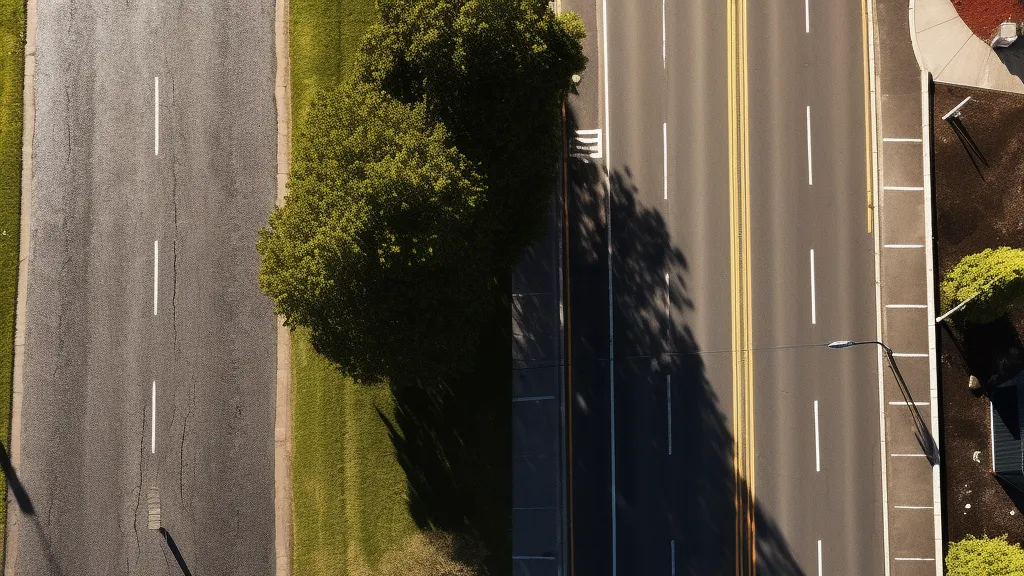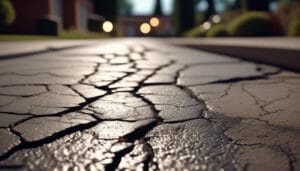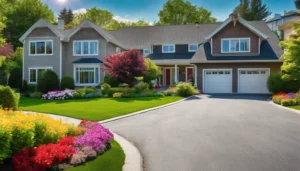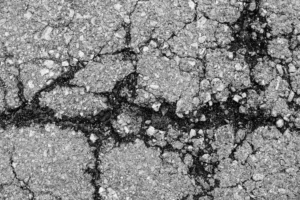Are you looking to upgrade your driveway and wondering which material is the best fit for your needs? Look no further! In this blog post, we will explore the key differences between two popular options: asphalt and blacktop. Whether you prioritize durability, affordability, or ease of maintenance, we’ve got you covered. By the end of this article, you’ll have a clear understanding of which material suits your driveway requirements best. So, let’s dive in and discover the ideal choice for your dream driveway!
Continue reading to uncover the details that will help you make an informed decision for your upcoming driveway project.
Differences in How Blacktop and Asphalt are Made
When it comes to choosing a driveway material, blacktop and asphalt are two common options many homeowners consider. Despite the similarity in appearance, blacktop and asphalt differ significantly in their composition and application. In this article, we will explain the differences in how blacktop and asphalt are made.
Blacktop, also known as bituminous concrete, is a mixture of stone, sand, and liquid asphalt. The asphalt used in blacktop is a crude oil byproduct known as bitumen. The mixture is heated and poured onto a gravel or crushed stone base. The black color of blacktop comes from the addition of carbon black, a fine carbon powder that provides color and increases durability.
Asphalt, on the other hand, is produced by heating different grades of petroleum to a liquid state. Aggregate, which can include crushed stone, sand, and gravel, is then added to the liquid petroleum to create a strong, durable paving material. Hot mix asphalt, the most common type of asphalt, is produced at high temperatures, which makes it suitable for use on major roadways and airport runways.
While both materials require proper maintenance to last, blacktop is typically easier to repair. Blacktop surfaces are porous and can easily develop cracks and potholes, which can be fixed by filling them in with more blacktop mixture. Asphalt, however, is less porous and requires a layer of sealant to prevent water damage and cracking.
In summary, blacktop and asphalt are both durable materials used for paving surfaces, but their compositions and applications differ significantly. Blacktop, made from a mixture of stone, sand, and liquid asphalt, is usually used for residential driveways due to its low cost. Asphalt, produced by heating different grades of petroleum and adding aggregate, is used for major roadways and airport runways. Proper maintenance is crucial for both materials, but blacktop is typically easier to repair.
Similarities Between Blacktop and Asphalt
Blacktop and asphalt are both commonly used as paving materials for driveways, roads, and other structures. Despite their differences in production and composition, the two materials share several key similarities that make them popular choices for constructing durable surfaces in a variety of climates and weather conditions. In this article, we’ll explore some of the similarities between blacktop and asphalt, including their durability, maintenance requirements, and suitability for use in different environments.
How is Blacktop Made?
Blacktop is a popular paving material used in many areas and is primarily used for the construction of roads, driveways, and walkways. It is composed of a mixture of stone, sand, and liquid asphalt, making it a durable surface that can withstand harsh weather conditions and heavy traffic.
The process of creating blacktop involves several steps, starting with the preparation of the mixture. The stone and sand are first heated and dried in a hot mix plant, which is a large facility designed for the production of asphalt mixes.
Once the stone and sand are heated, the liquid asphalt is then added to the mixture and thoroughly mixed until all ingredients are evenly distributed. The resulting blend is a viscous, sticky substance that is commonly known as blacktop.
After the blacktop mixture is produced, the next step is to lay it on the ground. This involves several steps, including preparing the base, applying a layer of asphalt, compacting the asphalt, and finally sealing it.
Firstly, the base of the surface where the blacktop will be laid is prepared. This includes removing any dirt, debris, and vegetation, and ensuring that the ground is level and smooth.
Secondly, a layer of the blacktop mixture is poured onto the prepared base, using a special machine called an asphalt paving machine. As the machine moves forward, it spreads the blacktop evenly across the surface.
Thirdly, the blacktop is compacted using a roller to ensure that the surface is smooth and level. This also helps to ensure that the blacktop is tightly packed, making it resistant to damage from heavy loads or harsh weather conditions.
Finally, a layer of blacktop sealer is applied to the surface, which helps to protect it from moisture and wear and tear.
In conclusion, blacktop is a durable material made by mixing stone, sand, and liquid asphalt. The mixture is produced in a hot mix plant and then laid on a prepared base, compacted, and sealed. This process ensures that blacktop is a robust and durable surface that can withstand heavy traffic, harsh weather conditions, and other external factors.
How is Asphalt Made?
Asphalt is a popular and durable surface material used for constructing roads, parking lots, and other infrastructure. It is a petroleum-based product made by combining different components through a series of processes. The main components of asphalt are aggregates, such as sand and gravel, and binders, like bitumen. Other additives may also be included to increase performance and durability.
The process of making asphalt starts with heating the aggregates to remove excess moisture. This is done in a special facility, called a hot mix plant, which is designed to heat and dry the aggregates. Once heated, the aggregates are mixed with the hot liquid binder, which is typically bitumen, to create the asphalt mixture.
The aggregates and the binder are mixed in precise proportions and at high temperatures to ensure that the mixture is homogenous and the particles are well-coated with the binder. The resulting mixture, also known as hot mix asphalt, is a thick substance that can be poured and spread onto a surface using special equipment.
Additives may be included in the mixture to improve its properties, such as increasing resistance to wear and tear, enhancing flexibility, or improving its resistance to weathering. These additives can vary depending on the specific application and conditions the asphalt surface will be exposed to.
Once the asphalt is mixed, it is applied to the prepared surface using an asphalt paving machine, which ensures an even and accurate application. The asphalt surface is then compacted, usually with a roller, to create a smooth and level surface. Finally, a layer of asphalt sealer is applied to protect the surface from weathering and to improve its lifespan.
In conclusion, asphalt is a petroleum-based material made by heating aggregates and binders at high temperatures to create a durable surface for roads, parking lots, and other constructions. The mixture is carefully prepared to ensure that it is well-coated and homogenous, with additives included to enhance performance and durability. When properly applied and maintained, asphalt surfaces can provide a durable, reliable, and cost-effective solution for various infrastructure needs.
Differences in What Blacktop and Asphalt Are Used For
Blacktop and asphalt are two popular materials used for paving different surfaces. While they may appear similar, they have different characteristics that make them suitable for specific applications. In this article, we’ll explore the different uses of blacktop and asphalt, as well as their advantages and disadvantages.
Common uses for Blacktop:
Blacktop, also known as hot mix asphalt concrete, is commonly used for paving driveways, sidewalks, parking lots, and bike paths. One of the main advantages of blacktop is its speedy drying time. It can be ready for use within hours of installation, which is a big plus for those who need quick results. Its ease of repairability is another advantage – it can be patched up rather than requiring a complete replacement.
However, blacktop also has some disadvantages. It’s susceptible to cracking and fading over time, especially when exposed to harsh weather conditions. It may also be less durable than its counterpart, asphalt, making it less suitable for high-traffic areas.
Common uses for Asphalt:
Asphalt, on the other hand, is a popular choice for major roadways, airport runways, and industrial parking lots. It’s a much more durable material due to its higher concentration of bitumen, which is a petroleum product that binds the aggregates together. Due to this durability, it’s also ideal for harsh weather conditions such as extreme temperatures and heavy rainfall.
One of the disadvantages of asphalt is its initial cost, which is typically higher than that of blacktop. However, it becomes more cost-effective in the long run due to its longer lifespan. Another disadvantage is that it’s not as easy to repair as blacktop – cracks and damages may require more time and effort to fix.
Overall, blacktop and asphalt each have their own advantages and disadvantages, making them suitable for different applications. It’s important to consider these factors when deciding which material to use for a specific project.
Uses for Blacktop
Blacktop is a well-liked material for paving driveways, sidewalks, parking lots, and bike paths, also known as hot mix asphalt concrete. Able to dry quickly and easy to repair, it’s a great choice for those seeking fast results. Nevertheless, blacktop may not be as long-lasting as asphalt and can crack or fade, especially in harsh weather.
Advantages of Blacktop
Blacktop is a popular option for driveway surfaces due to its many advantages. One of the most notable advantages of blacktop is its easy reparability, making maintenance costs relatively low compared to other types of paving materials. Cracks or other damage to blacktop surfaces can be easily repaired, meaning that property owners do not need to worry about costly and time-consuming repairs.
Another advantage of blacktop is its quick installation time. The application process for blacktop is relatively speedy and requires less time compared to other paving materials. Furthermore, blacktop requires little time to cure before it can be used, which means it can be used shortly after installation.
Blacktop surfaces are also incredibly durable. The material can withstand heavy traffic and harsh weather conditions, making it an excellent option for use in airport runways or major roadways. Its strength and endurance make it an ideal choice for homeowners and property owners in areas that experience harsh weather conditions.
In addition to its practical advantages, blacktop surfaces also have aesthetic appeal. Blacktop’s dark color can complement the natural stone surroundings and provide a polished look to your property. Blacktop surfaces also come in different types, so you can choose one that best suits your property’s design and curb appeal.
Overall, blacktop surfaces are a durable and easy-to-maintain option for property owners. With low maintenance costs, quick installation time, strength, and aesthetic appeal, it’s no wonder blacktop is such a popular choice for driveways and other paved surfaces.
Disadvantages of Blacktop
While blacktop surfaces offer many advantages, including durability and aesthetic appeal, they also come with several disadvantages that property owners should be aware of before choosing this material for their paving needs.
One of the primary issues with blacktop surfaces is their tendency to crack and deteriorate over time. Unlike some other paving materials, blacktop is not as durable, and requires proper maintenance to prevent such issues. Failure to maintain blacktop surfaces can lead to costly repairs or even replacement down the line.
Another disadvantage of blacktop is its ability to absorb and retain heat, particularly in hot climates. This can be problematic for property owners who may experience discomfort or damage to their blacktop surfaces due to prolonged exposure to high temperatures.
Over time, blacktop surfaces may also experience issues with fading and discoloration. While some fading is normal over the months and years after installation, prolonged exposure to sunlight and other environmental factors can cause more significant discoloration.
Moreover, maintenance costs for blacktop surfaces can add up over time, especially in harsh weather conditions. Property owners may need to invest in periodic sealing and repairs to prevent cracking and other damage, which can be expensive.
Therefore, while blacktop surfaces offer many benefits, it is important to consider the potential drawbacks before making a final decision. Property owners must stay on top of the maintenance, so their blacktop surfaces remain in good condition, and the cost of repairs and replacements is minimized.
Uses for Asphalt
Asphalt is a commonly used material in the construction industry, known for its durability and flexibility. It is primarily used for paving roads, but its applications extend far beyond that. In this section, we’ll explore the various uses for asphalt and how it has become an essential part of modern infrastructure.
Advantages of Asphalt
Asphalt is a highly versatile paving material that has several advantages. Here are some of the key benefits of using asphalt as a paving material:
- Durable Material: Asphalt is a highly durable paving material that can withstand heavy traffic and harsh weather conditions. It is able to resist the damaging effects of UV rays, moisture, and chemicals, making it ideal for use in areas with high traffic volumes or extreme weather conditions.
- Resistant to Cracking: Unlike other types of pavement that are prone to cracking or crumbling, asphalt is able to flex and shift with the natural movement of the ground. This makes it less susceptible to cracking or damage, extending its lifespan and reducing the need for frequent repairs.
- Snow and Ice Melting: The black color of asphalt helps to absorb more heat from the sun, which can help to melt snow and ice faster in colder climates. This can be a major advantage for areas with heavy snowfall, as it can help to reduce the need for costly snow removal services.
- Cost-effective Solution: Asphalt is a cost-effective solution for large paving projects such as major roadways and airport runways. It is relatively easy to install and maintain, and can be much more affordable than other types of paving materials.
In summary, asphalt is a highly durable and cost-effective paving material that is able to withstand harsh weather conditions and heavy traffic. Its black color can also help to melt snow and ice faster in colder climates, making it a versatile solution for a wide range of paving needs.
Disadvantages of Asphalt
While asphalt may be a durable and cost-effective paving solution, it is not without its challenges. Here are some of the disadvantages of asphalt:
- Cracks: One of the biggest challenges with asphalt is its tendency to develop cracks over time. These cracks can happen for a number of reasons, including shifting soils, heavy traffic, and extreme weather conditions. If left untreated, these cracks can grow larger and eventually lead to significant damage to the surface.
- Fading: Another disadvantage of asphalt is its tendency to fade and lose its dark color over time. This can happen as a result of UV rays from the sun, chemicals, and other environmental factors. As the surface fades, it can become less aesthetically appealing and may require more frequent maintenance to keep it looking its best.
- Maintenance Costs: While asphalt may be a cost-effective solution for large paving projects, it does require regular maintenance to keep it in good condition. This can include repairs to cracks and other damage, resealing the surface, and repainting lines and markings as needed. These maintenance costs can add up over time, especially in areas with harsh weather conditions or heavy traffic.
- Harsh Weather Conditions: As mentioned earlier, asphalt is vulnerable to damage from extreme weather conditions. In colder climates, for example, freezing and thawing cycles can cause the surface to shift and crack. In warmer climates, meanwhile, heat from the sun can cause the asphalt to become softer and more susceptible to damage from heavy traffic.
- Asphalt Sealer: Applying asphalt sealer regularly is one way to mitigate some of the cracking and fading issues with this type of pavement material. The sealer helps to protect the surface from UV rays, moisture, and other environmental factors, while also helping to fill in small cracks and other damage.
Overall, these challenges with asphalt can impact the longevity and durability of the surface, potentially leading to costly repairs or replacement down the line. Proper maintenance techniques, such as applying asphalt sealer regularly and addressing cracks and other damage as soon as they arise, can help to extend the lifespan of the surface and keep it looking its best for years to come.
Different Grades or Types of Asphalt
Asphalt is a popular material for paving surfaces due to its durability, affordability, and easy maintenance. There are different types and grades of asphalt available, each with its own unique characteristics and suitability for specific applications.
The most common types of asphalt are hot mix asphalt, warm mix asphalt, and cold mix asphalt. Hot mix asphalt is the most commonly used type of asphalt for roadway and parking lot construction as it is durable, flexible, and can be easily placed and compacted. Warm mix asphalt is a variation of hot mix asphalt that is produced and placed at lower temperatures, reducing emissions and energy consumption. Cold mix asphalt is a less common type of asphalt that is used for small repair jobs and temporary patching.
Hot mix asphalt is further divided into three grades: base, binder, and surface. Base grade asphalt is the most durable and contains a higher percentage of coarse aggregates, making it suitable for heavy traffic areas such as highway interchanges or airport runways. Binder grade asphalt is less durable than base grade but is more flexible, making it ideal for areas with varying temperatures or frequent freeze-thaw cycles. Surface grade asphalt has the highest amount of fine aggregates, giving it a smooth texture and making it suitable for high-traffic areas such as parking lots or residential streets.
The durability, porosity, and flexibility of each type and grade of asphalt are influenced by several factors, including the type of petroleum product used, the size and shape of the aggregates, and the production and placement temperatures. Hot mix asphalt is the most durable due to its high coarse aggregate content, while cold mix asphalt is the least durable due to its lower production temperatures and lack of compaction. Porosity is also affected by the size and shape of the aggregates, with smaller, rounder aggregates creating a more porous surface than larger, angular aggregates. The flexibility of asphalt is determined by the amount and type of bitumen used in the mix.
Overall, each type and grade of asphalt has its own strengths and weaknesses, making it important to choose the right one for the specific application. Base grade asphalt is best suited for heavy traffic areas, while surface grade asphalt is ideal for areas with lower traffic volumes and a focus on aesthetics. Warm mix and cold mix asphalt are suitable for temporary repairs and patching, while hot mix asphalt is the preferred choice for long-lasting, durable surfaces.
Facts About Asphalt and Blacktop
Asphalt and blacktop are two commonly used materials for paving and surfacing projects. While these two terms are often used interchangeably, there are some key differences between them that are worth exploring.
One interesting fact about asphalt is that it has been used for thousands of years. The ancient Babylonians used a primitive form of asphalt as a binding material for bricks and waterproofing. Today, asphalt is used to pave roads, parking lots, airport runways, and even as a lining material for swimming pools. It is also one of the most recycled materials in the world, with over 99% of all asphalt being reused and recycled.
Blacktop, on the other hand, is a specific type of asphalt pavement that is commonly used for residential driveways, small parking lots, and walkways. Blacktop gets its name from its dark color, which is achieved by adding black pigment to the asphalt mixture.
The main difference between asphalt and blacktop is the size of the aggregates used in the mix. Asphalt typically contains larger aggregates, such as gravel or stone, which make it more suitable for high-traffic areas such as highways and airport runways. Blacktop, on the other hand, contains smaller aggregates that give it a smoother texture and make it ideal for residential and commercial applications.
In terms of durability, both asphalt and blacktop are known for their strength and resilience. However, the type of asphalt used can also play a role in its durability. Hot mix asphalt, for example, is the most durable and is typically used for high-traffic areas. Cold mix asphalt, on the other hand, is less durable and is often used for temporary repairs and patching.
When it comes to choosing between blacktop and asphalt, there are several factors to consider. Climate is one important consideration, as certain types of asphalt may be better suited to hot or cold climates. Traffic volume is another key factor, as heavier traffic areas may require a more durable paving material.
Finally, maintenance costs should also be taken into account when choosing between blacktop and asphalt. While both materials require regular maintenance to prevent cracking and fading, blacktop typically requires more frequent sealing and patching than asphalt.
Overall, both asphalt and blacktop have their own unique characteristics and uses. By understanding the differences between these popular paving materials, you can make an informed decision when it comes to your next surfacing project.
Conclusion
In the battle of blacktop vs. asphalt, it’s clear that both materials have their unique advantages and considerations when it comes to selecting the perfect driveway surface. Blacktop, with its affordability, ease of repair, and suitability for residential use, is an excellent choice for those seeking a cost-effective and low-maintenance option. On the other hand, asphalt shines in its durability, resistance to harsh weather conditions, and ability to handle heavy traffic, making it ideal for major roadways and high-traffic areas.
As you weigh your options, remember to consider factors such as climate, traffic volume, budget, and desired longevity. Each driveway project is unique, and what may be the right choice for one homeowner may not be the best fit for another. Consulting with professionals and considering local conditions can provide valuable insights to make an informed decision.
Whether you opt for the affordability and flexibility of blacktop or the long-lasting strength of asphalt, proper maintenance and regular inspections are crucial for preserving the integrity of your driveway. By investing in routine care and promptly addressing any issues that arise, you can ensure a smooth and durable surface that enhances the curb appeal and functionality of your property for years to come.
We hope this comprehensive guide has shed light on the differences between blacktop and asphalt, empowering you to make the best choice for your specific driveway needs. Now, armed with knowledge, it’s time to pave the way to your perfect driveway!



